Nola and Myra Hewitt were members of Dunedin’s pioneering country band The Tumbleweeds. Nola married the lap steel guitar player Colin McCrorie, and Myra the singer/guitarist Cole Wilson. This is the story of The Tumbleweeds’ early years, written by Nola, who died in 2009 aged 80.
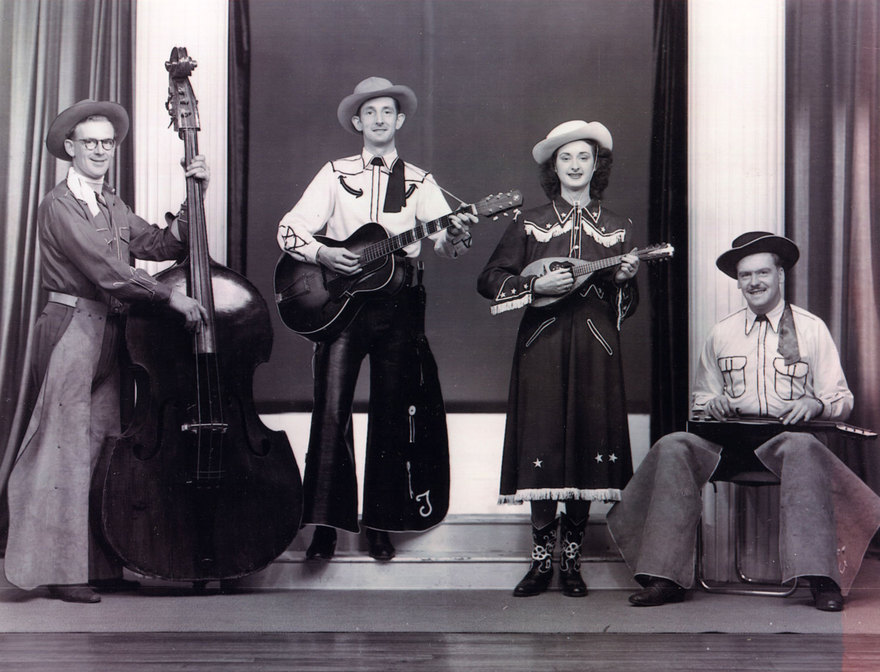
The Tumbleweeds of Dunedin, 1950. From left: Doug Reeve, Cole Wilson, Nola Hewitt, and Colin McCrorie. Myra Hewitt was yet to join the band. - Colin McCrorie collection
We wanted The Sons of the Pioneers’ ‘Tumbling Tumbleweeds’ as our theme song when we started broadcasting, but another group already had it as their theme so we settled for ‘The Cowboy’s Dream’.
However, I am jumping ahead with that, so I will start at the beginning for all of us.
Myra and Nola Hewitt
The Hewitt household was a hive of activity and excitement. It was Saturday and everyone was very busy doing their allotted jobs in preparation for the party that Mum and Dad were putting on at our house that night. “Get Charlie to help move the table out Andrew, and Myra and Nola can then put the chairs around the walls.” These orders from Mum, who was preparing quite a delicious supper for later.
The day had been so busy – the floor was scrubbed and polished and the rugs lifted for dancing. There was not much alcohol, but Dad had ordered a keg of beer for the men and some sherry for the ladies. When all the work was done, we were all scrubbed up and ready for the guests to arrive.
Myra and I had our best dresses on and were full of anticipation. The guitars and banjo-mandolins were out of their cases and tuned.
At last, at about 8pm, they arrived – aunties, uncles, and friends, about 15 to 20 people – and the party was underway. The music was great! Mum on her banjo-mandolin, Dad on steel guitar and Charlie Robertson, a very dear friend who lived with us, on another banjo-mandolin. He was a wonderful entertainer, and his playing and singing were great to hear. Charlie and Mum played a lot in harmony and Dad accompanied on the steel guitar.
The music catered for most tastes, but the favourites were cowboy, Hawaiian and Māori. There was a lot of dancing and anyone who could gave an item of some sort. “Your turn Nol – would you play for us now?” someone would ask, and I would rattle out a song on the mandolin, maybe something like ‘Little Green Valley’ with Mum on harmony, wishing frantically that I wasn’t so shy.
Later there was supper – pork bones and oysters among other things. Oysters were not nearly so expensive as they are today. When we were younger, Myra and I would have to go to bed after supper, but we had had such a wonderful night so went with good grace.
Parties then were really great fun and were that way until radiograms came upon the scene. That was when everyone just stood around in groups, talking and drinking, and some dancing. That was okay too, but the parties of the old days were more fun, with everyone joining in together, lots of singing and dancing and people of all ages came along. There was no obvious generation gap in our young lives and, years later, when we were adults and went to parties, it was still the same with us. Our parents and aunts and uncles often came along with us. Those days were the best of all.
Listen to The Tumbleweeds’ first release, ‘The Bushman's Rodeo’ (Tanza, 1949)
However, to hark back to the “old days”. Despite the beer and sherry, we never saw our father the worse for drink and Mum would have one sherry or none at all. If she thought some fellow may have had a little too much, she – in a very nice way – would tell him to take it more slowly. She admitted to us years later that, on one of these nights when she thought things were becoming a little too boisterous, she sneaked out to the kitchen and turned the tap of the keg on and let some of the beer run down the plughole. Imagine the hullaballoo if she had been caught doing this by the men!
Next day, of course, was general clean-up again: floor scrubbed and polished (all done on the knees) rugs and chairs back in place. And, over dinner, a general “post-mortem” on the party, the funny parts and so on. I have such nostalgia for those days. My ears and eyes took in as much as they possibly could and, to this day, I still remember the words of a lot of the songs that were sung then.
Friends of Charlie Robertson asked if they could bring a fellow to one of our parties. He was a Tahitian man, Charlie Murray, who was very fond of island music and dancing. Wow! I will never forget the impact he made on us with his hula dancing. It was so lovely. He was as graceful as a woman when he did the slow hula and a great muscular man for the male type of hula.
We all loved him and, after meeting this rather shy fellow, he was always welcome at our house. I was completely fascinated with his dancing. We will meet up with him again later in this story.
A TAHITIAN MAN, CHARLIE MURRAY, WAS AS GRACEFUL AS A WOMAN Doing THE SLOW HULA. WOW! THE IMPACT HE MADE ON US.
Now to hark back much further. When Mum was carrying me, the last of five children, she had trouble with varicose veins and was ordered by her doctor to rest up every afternoon. At these times, she often played her mandolin. She claimed that I must have heard it because I am the only one of the family to have really taken to the instrument.
Colin [McCrorie], my husband, said maybe Zell was not too far wrong as he had read an article on what can affect a fetus and what it might be able to hear. An interesting theory. We have since read more on this and apparently it is true.
I must say here, that I really did not have a great welcome into this world. Mum told us this story in later years. Quite understandably, like others of that era, Mum and Dad did not particularly want another “mouth to feed”. Those were not the days of contraceptive pills and child allowance, and my mother was advised by a friend to have a hot mustard bath and drink a glass of hot gin. My poor mother! Ghastly for a one-sherry lady, and that very infrequently.
However, despite all this, I duly arrived, a healthy nine-pound (4.08kg) baby. When I was brought home for the family to admire, Myra suggested throwing me in the Leith (a waterway in Dunedin) and my brothers laughed because I had neither hair nor teeth. Anyway, I was loved as all the others were. Not surprisingly, perhaps, when I grew up, I quite enjoyed a gin.
Mum recalled the time when, around two and a half years of age, I had dragged her banjo-mandolin case into the back yard, opened it and was trying to play the instrument, so they put me on a seat and took a photo.
Evidently, I began my “singing career” at such an early age that I can’t remember it: again, around two and a half years. I sang ‘Springtime in the Rockies’ (as “pingtime”), and would do this for vistors. That must have been before I became so very shy. Both Myra and I suffered rather badly from shyness and lack of confidence, which held us back quite considerably.
At the age of three or four I was taught, by my father, how to do the Barn Dance. He was always very fond of dancing. I loved these sessions up and down the big kitchen floor, but now wouldn’t have a clue how to do that old timer. At this stage, too, my mother started teaching me how to play the banjo-mandolin. All the other kids had gone to school and I remember vividly sitting on a chair in front of the kitchen fire this day.
Mum was in the pantry, a small room off the kitchen, doing the dishes, so we couldn’t see one another. I had the banjo-mandolin on my knee and was calling out to her to tell me where to put my fingers for the notes of ‘Sweet Jenny Lee’. I had been told the names of the strings, then the frets for first, second, and third fingers. Mum had to think quickly and would shout out to me “one on A, open A, three on D” and so on.
So I soon learned the songs, the first being ‘Sweet Jenny Lee’, followed by ‘Lamp Lighting Time in the Valley’ and ‘Little Green Valley’. It was all go from there on. I began to pick the tunes out by myself and Mum would borrow Charlie’s mando and play harmony with me. I then progressed to harmony playing too, and just loved it.
Life went on. It was my fourth birthday and my parents and Charlie had just bought a radio – a great excitement for all of us. There used to be a children’s session hosted by a fellow who went under the name of “Big Brother Bill”. I was put on Mum’s knee to listen to him because she had written in to have my birthday put over the air. Big Brother Bill wished me a happy birthday and said “Nola, if you look in the wardrobe in your mother’s bedroom you will find a present there.”
Oh boy! All hell broke loose. My brothers immediately ran out of the kitchen and up the passage to get my present, I thought. They were only teasing me, of course, but I didn’t know this. I was crying and struggling to get down from my Mother’s knee and, because of this, missed the rest of Big Brother Bill’s talking about how he had heard I played the banjo-mandolin, etc. It was a pity he had not mentioned the present last, but he was not to know I had brothers who teased so much. These sort of things went to make a good family life I guess, which we certainly had – not much money but plenty of loving care.
As I got older, my shyness got worse, and Myra was the same. At last, I was old enough to go to school and felt real good about that. We started at George Street School (which is now George Street Normal School) and would go home for lunch everyday, which was a fair hike to the bottom of Dundas Street, overlooking Logan Park. From there we moved to Caversham at the other side of the city, when I was in Standard One, aged seven.
Everything went along as usual and, about now, Charlie bought me a second-hand mandolin. The same is to be heard on some of our Tumbleweed recordings. It is a very old instrument made in Napoli, Italy, in 1903, according to the certificate inside the bowl back, and it has such a sweet tone. It is amazing to know that Charlie paid 17 shillings and sixpence ($1.75) for it at a saleroom in town. Thelma McLaren, née Moore – the Moore family were dear friends of our family – suggested to Mum that I go with her to Radio 4ZD (later to become 4XD, then Radio Dunedin) to play the mando on a session called The Smile Family conducted by two good people known as Uncle Doug (Doug Bruce) and Aunt Mary (Mary Rennick). That was the beginning of a long association with that radio station as, some years later, Myra and I went there to sing.
Mum, Dad and Charlie were in great demand and would be invited out frequently to play their music. Mum was also very shy and, one time, Dad was asked if they would play at a social the following Saturday night. Mum didn’t want to, and Dad asked me if I would go instead. Charlie was away at the time. Oh yes, I would go, but when Saturday arrived, my courage disappeared and I wouldn’t go without Mum so the three of us played there. Nervousness struck again. I did so much want to do these things, and, indeed, made myself do some of them, but it was not easy.
THE TEACHER SAID “VERY NICE, BUT A PITY YOU HAD NOT CHOSEN SOMETHING MORE SUITABLE.” MY MIND WAS ON “COWBOY” MUSIC.
Later I was asked to play at a school concert and chose ‘Riding Down the Sunset Trail’. The next day, our teacher thanked those who had performed – Jack for a lovely piano-accordian solo, Glyn for a beautiful violin solo and Nola – “very nice but a pity you had not chosen something more suitable.” I guess I could have played something like ‘Santa Lucia’ or ‘Invercargill March’, but my mind was on “cowboy” music, as it was then known.
On Friday nights, after listening to Dad and Dave from Snake Gully, we would all gather around the radio for Pinto Pete and his Ranchhands, a 15-minute programme of cowboy music from the USA: a highlight of the week for us.
I haven’t yet written anything about Myra’s talents, the reason being that she took not much interest in music until she was older. She and I were inseparable and have been close all through the years. She looked after me, bossed me and generally was, and is still, a wonderful big sister. Sure we had the usual childish disagreements, but have never had a quarrel as adults. She has always been my best girlfriend. We have had lots of fun over the years and I don’t know just what I would have done without her. She says she reciprocates these sentiments. Mum once said, with a twinkle, that she was glad the hot gin didn’t work.
Myra had great ideas, always the leader, and I followed. With two or three of our friends, Myra formed a club which she called The Silver Star Club, and with her as leader we had some great times including a concert or two. These were, of course, private, held in our bedroom and, on one of these occasions, we had fake microphones made from painted cardboard boxes attached to the top of a broomstick, an idea copied from the grownups’ parties and modified by Myra to suit us.
About this time we started singing together and tried all sorts of songs which we had heard on radio or on record. Our voices were similar and seemed to blend quite well. Unless Mum was in the same room as we were, even she could not always tell who was singing which part. Myra’s voice was higher than mine but sometimes we would swap parts and it was not easy to detect this. Perhaps my voice was a little stronger. Even now, on some of our recordings, some people cannot say for certain which is which. Myra has never done any solo vocals and I must say it took me some time before I had enough courage to do so. We were singing Cowboy’s Dream one night at The Smile Family and we were to sing the verse in unison with harmony in the chorus. For some reason Myra left me to sing the second verse by myself. I nearly passed out with fright which was evident by my very shaky solo.
We were still at school when war was declared. Our brother Dave joined the navy and Cas the army. Just prior to this, Cas had married Elsie Armishaw and they lived at our house. A little later Dave married Norma Scott when he was stationed in Auckland. These weddings were before the boys went overseas. What a worrying time for Mum, Dad and Elsie and Norma. Those days were not too bright for them but we were very lucky that they both came home.
Two favourite singers of the day for Myra and myself were sisters Dorothy and Mildred Good, from the USA, who went under the name of “The Girls of the Golden West”. We latched on to quite a few of their numbers, some of which are on our Tumbleweed recordings. We sang once a week for some time on The Smile Family night with the mandolin for accompaniment. Then, on reaching the teens, Myra began taking lessons on the steel guitar from Bill Coulter who taught all kinds of stringed instruments in Dunedin’s “Begg’s Musical Army”. Myra had a lovely touch on this instrument.
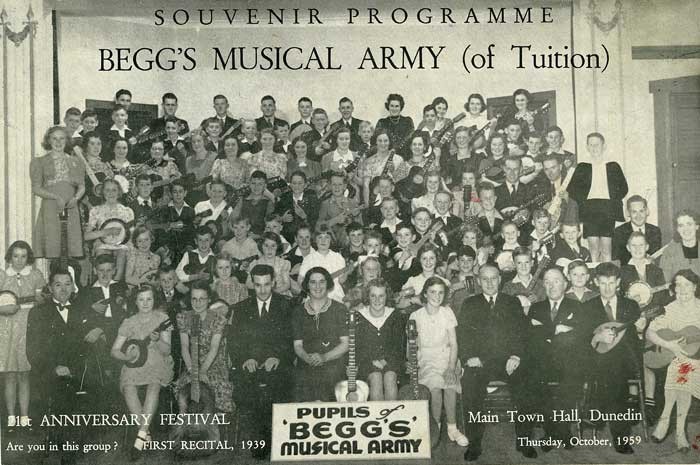
The 1939 Begg's Musical Army and tutors, 1939. This was the cover of a 1959 programme for a 20th anniversary recital at Dunedin Town Hall.
About this time a talent quest was held in Dunedin. The finals were broadcast and a Hawaiian trio, comprising Colin McCrorie, on electric steel guitar, his sister Maureen on Spanish guitar with Betty Nicholls on vocal, performed a popular number of the day, ‘Sing me a Song of the Islands’. It was so beautiful that Mum, Myra and I wrote in and voted for them. It was judged by public vote and a lot of other people must have thought as we did because they came second to a classical singer. I was then in my early teens and, of course, had then never met Colin McCrorie.
I went with my sister-in-law Elsie to learn the ukulele from Mr Coulter, later progressing to the Spanish guitar, which helped supply some rhythm for Myra’s steel. It was also a better instrument than the mando for backing our singing. I tried to learn music but was a bit of a failure there unfortunately. Mr Coulter concluded, finally, that I had too strong an ear. He tricked me, at one of my lessons, as were playing a piece of music and said “Where are we now, Nola?” I was looking at the music but could not tell him where I was because I had learned it by heart and, as I could pick out a tune easily, I couldn’t be bothered learning theory – naughty girl.
Now armed with a guitar bought for me by my dad (I shall never forget the thrill of playing my first cowboy runs on it) we kept up the broadcasts at 4XD with The Smile Family. To overcome our nervousness, one night Mum thought some sal volatile [smelling salts] might work for us. It did not solve our problem and, indeed, I think we would rather have been nervous than take that vile-tasting stuff.
We sang all types of songs besides our beloved cowboy and Hawaiian, and went out on a few concerts. One of these was held at Talboys Home for the Aged and put on by a group from The Smile Family. Myra and I remember feeling quite upset because, during our item, some of the audience seemed to be in tears. Evidently, as it was later explained to us, there were some old soldiers there from the First World War and our song ‘Long Long Trail’ brought back memories for them.
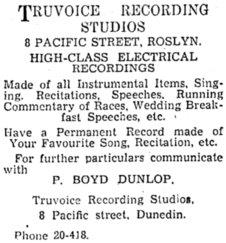
The Truvoice Recording Studios. - Otago Daily Times, 2 June 1938
One day Mum saw an advertisement in the paper stating there was a recording team in town and she asked if Myra and I if we would make a record for her and Dad. There were no professional recordings done in New Zealand then. The cost was 30 shillings (30/- or $3) and that was equal to a week’s rent for some people, but they managed to find the cash. Nearly dead with fright we went down town to the large room these people had rented and squeaked out ‘Sunny Australian Sweetheart’ (Buddy Williams) backed by ‘My Old Nevada Home’ (Girls of the Golden West). The second side had not been quite filled and they asked if we would like to do part of another song, so we sang an Island number ‘It Happened in Kaloha’ which faded out quite well. I had been learning the guitar just a short time, which is evident by my playing and the monotony of my “Cowboy Runs”. I had copied them from Buddy Williams’ recording but I overdid them a little. Mum and Dad were happy with it. This recording was a very lightweight acetate disc and needed a light pickup, otherwise it would be gouged. It has now become very precious so Wesley, Myra and Cole’s son, put it on tape in case the record got broken.
While still at school, Myra and I were taken to the spectators’ gallery at the Town Hall to watch our brother, Dave, take part in a ballroom dancing competition. What a thrill to see all the ladies in their long evening dresses and to see Dave and his partner, Phyllis Whyte, win. From then on, an ambition of mine was to learn to dance properly, and perhaps one day become Dave’s partner. Dave was a tutor in ballroom dancing at a place called The Happy Feet Club and at the age of 12 I used to go every week with Myra and our good friend, Ena Phillips. This was another highlight for us.
When I was around 17 years old Dave arranged for me to take lessons from his teacher, Len Marsden, and said if I was okay I could be his partner. So began a number of very busy years with Dave and me enjoying lots of competition dancing, taking medal tests and doing floor shows at various functions. We were Otago Amateur champions for three consecutive years, placed second (beaten by half a point) in the South Island Championships and third in the New Zealand Latin American Championships.
Dave was a superb dancer, so how lucky could I be? I went as far as Gold Star in the amateur section but Dave went on for his professional status and although I partnered him, I didn’t enter – I wish now that I had. It could be a costly hobby for a young apprentice ladies’ hairdresser but again I was fortunate to have Myra who was a very clever dressmaker and made my beautiful ball gowns, with masses of tulle, on Mum’s old treadle sewing machine. I am a hopeless seamstress, but could help with ideas and the sewing on of thousands of sequins.
Now I must include our other brother, Cas, who was a real fan of country and western music and was always a faithful fan of the Tumbleweeds. He played banjo-mandolin a little but did not persevere with it, also the harmonica and Jew’s harp. He had a good voice too. Cas was not the slightest bit interested in dancing, while Dave, on the other hand, could not sing a note in tune and was keen on the big band sound and jazz, and did not particularly like country and western.
Now I hark back to our dear friend, Charlie Murray, the expert Tahitian hula dancer. He was a regular visitor at our home and, I guess, it was around the same time that I started learning ballroom dancing that Charlie began giving me lessons in the hula. I was stiff at first, but gradually caught on, and was able to understand what the hand movements meant. What a lovely dance. The slow hula so graceful and the fast one so rhythmic. I just loved it. Charlie taught us to make hula skirts and leis. Mum loved making the leis. We did quite a lot of hula shows around our town at balls and social occasions.
At a Musical Army concert, Charlie Murray and I did the hula. Guest artists included Colin McCrorie and the Hawaiian Serenaders.
End-of-year concerts were held by Begg’s Musical Army and run by Bill Coulter. These were great fun and the atmosphere on the night so exciting. I shall never forget Mr Coulter tuning all those stringed instruments before the show. Myra was took part, on her steel guitar and I, at first, with my uke (which Charlie Robertson had bought for me) and, later on, the Spanish guitar. There were rehearsals for these concerts and, at one of them, our ears caught a great sound of nimble fingers playing great music on a Spanish guitar. This was done by a fellow called Colin Wilson, who used to like to “sit in” with the band. He did not learn from Mr Coulter but was a terrific guitarist and, besides other music, liked to play jazz. Everyone was most impressed with his playing and it added such a high-class sound to the band.
A friend who played Spanish guitar with Myra’s group left town and we wanted someone to replace him, so Mr Coulter suggested asking Colin Wilson to sit in with us. That was how we met Cole Wilson. We had many a musical session at our home and discovered we could also get together on some vocals. We had heard Les Wilson over the radio singing at the Town Hall Dance. He was a good cowboy vocalist and was Cole’s younger brother. Cole was also an avid fan of cowboy music. Sometimes Cole would bring a friend with him, Doug Reeve, who was also keen on our sort of music. Those were really great days.
At one of the Musical Army concerts Charlie Murray and I did the hula. Guest artists included the Hawaiian Serenaders with Colin McCrorie on the steel, he having earlier been a pupil of Bill Coulter. Mum, Dad, Myra and I had been fans of this group and never missed their radio broadcasts. The founder bass player for them, Bill Ditchfield, approached Charlie and me backstage after we had danced and asked if we would dance for the Hawaiian Serenaders when they needed a floor show. I was so excited about this, having such a love for Hawaiian music too, and finally meeting – at last – our idol on the steel guitar, Colin McCrorie.
The Tumbleweeds
Life was pretty hectic and interesting, and the Hewitt household was like a busy railway station, with people coming and going. We spent a lot of time playing music and Myra’s group was good. Cole Wilson came to our home often because he, too, liked to play music whenever he could. Everyone, it appeared, played an instrument of some kind, or was able to do some vocals. We spent many happy times then and, when we discovered how versatile Cole was with his guitar playing and how good a country singer he was, we found ourselves trying out various songs in harmony vocals. Not too bad, we thought. Cole had plenty of cowboy records which we had never heard of, a favourite old-time group being the Carter Family. There were parties galore at our house, only now the younger ones would play most of the music.
By this time I was hairdressing, and thoroughly enjoying that. Also ballroom dancing and, with our music too, life sure was busy. It eventuated that Cole, Myra and I went to Radio 4YA to do a short broadcast, one of the songs being ‘Maple on the Hill’. It seemed to be well received. Shortly after this, Bill Ditchfield approached us with the idea of starting a cowboy group with Colin McCrorie on steel. At this stage there were not many – if any – groups doing cowboy music, usually it was one person singing with a Spanish-guitar accompaniment. We all thought Bill’s idea was interesting, and had our first get-together in March 1949, with promising results. We all seemed to be compatible and had ourselves a great time. We had a few of these sessions and Bill, having broadcast with the Hawaiian Serenaders, approached station 4YA for an audition for the group. Shortly after, we were accepted for some weekly broadcasts.
Life became busier than ever with practices during the week for the Saturday night broadcasts. How we ever fitted everything into a week, I don’t really know! These broadcasts were performed live, of course, which was a bit of a nerve-wracking business.
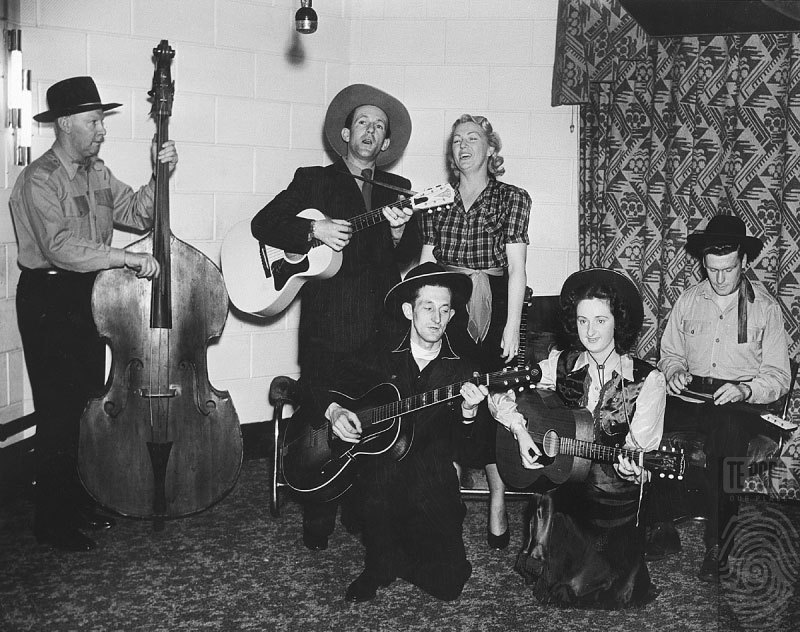
The Tumbleweeds with Tex Morton, Dunedin, October 1949. From left: Bill Ditchfield, Tex Morton, Cole Wilson, Sister Dorrie, Nola Hewitt and Colin McCrorie. - Colin McCrorie Collection
But first of all we had to choose a name for the group. Various ideas were suggested: Trail Riders? Range Riders? Pals of the Prairie? Quite a few were tossed around and then Cole suggested “The Tumbleweeds”. It was a hit with us all! The next thing was to decide on a theme song for these broadcasts. Someone suggested, and we all agreed, that ‘Tumbling Tumbleweeds’ would be the one but, unfortunately, were were told by 4YA that another group had this song as their theme. A bit disappointing really, as these others were not cowboy performers. However, we settled for the chorus of ‘Cowboy’s Dream’.
I still had not sung solos – just harmony to Cole’s singing. After a few of these broadcasts Bill asked why I didn’t sing solo, and I said I was too nervous for that. He kept at me and finally I agreed to try to sing a solo. I think I chose ‘Worried Mind’, which I had [practised] at home all that Saturday anyway! I can’t recall just how successful that was, but I did solos from then on so it must have been right enough. This gave us a little more variety with Cole’s solos and mine, and our duos. We usually did six broadcasts, then after a break would get a further invitation from 4YA to do another six. These seemed to be popular with the listening public – so much so that many letters were received by 4YA from our fans asking for their favourite numbers. Because of this we made some of our broadcasts “Request” nights, and did as many of the songs asked for as was possible. This made us feel really good – people liked our music!
As I mentioned before, these broadcasts were quite nerve-wracking because they went straight out to the public – no tapes in those early days. We would arrive at the studio soon after 7pm, tune up our instruments and have a balance. Colin would go through to the technician’s room and balance the voices and one of us would go to balance his guitar playing. The tension mounted – the words of our songs, plus any other relevant data, like the key, the vocal and instrumental sequence, were placed on metal music stands and we would wait, a little pale, for the red light to come on. Then Cole’s opening chord on the guitar, then our voices:
Roll on roll on
Roll on little dogie
Roll on roll on Roll on roll on
Roll on little dogie
Roll on
Colin then played a chorus with the announcer coming in over him, something like, “Welcome to another programme of songs with The Tumbleweeds” – and we were away on our 15-minute programme. We were not permitted to cough, sneeze, clear the throat, or make any other extraneous noises for that quarter-hour, just music. One night, on reaching up to throw the finished piece of paper to the floor, my rings clanged on the music stand. What a noise that made and everyone glared at me which was not good for the nerves. It sure was a relief to see the red light change back to green.
Not so many songs were written then for girls to sing. The words were for a man so, unless we changed them, I felt a bit silly singing a love song to a girl! Cole said he would compose one for me and came up with ‘Violets Blue’ which became a favourite. He proved to be very proficient in this field, and wrote quite a lot of really great songs.
Colin’s steel guitar had a beautiful sound. His change-over from Hawaiian to country style was never really fully complete, his inherent love of Hawaiian music still, to some extent, showing through. This fact, no doubt, contributed – to some degree – to the unique and readily recognisable sound of The Tumbleweeds.
We had a few months of broadcasting and in September of the year we started (1949) we were given the opportunity to record on the then-new TANZA label for Radio Corporation of NZ Ltd. This entailed the four of us travelling to Wellington for a weekend, at their expense. The name Tanza, we were told, stood for “To Advance New Zealand Artists” but in the opinion of some today, the word “advance” was, in fact, “assist”. Whichever way, I guess the objective was the same. In those days all recording expenses were met by the company, with our receiving royalties on sales. A 78rpm record sold for 4/6d (45c) and of that we received 3d (2½c) among us.
That was the beginning of a very long and busy career for the Tumbleweeds – indeed much longer than any of us would ever have imagined. I found it hard to believe that we were on record. Tanza was a heaven-sent opportunity for New Zealand talent to forge ahead and be recorded, processed, and pressed in New Zealand. Over the years prior to 1949 numerous New Zealand artists had made recordings but they had to be processed and pressed in Australia as there were no such facilities in New Zealand at the time.
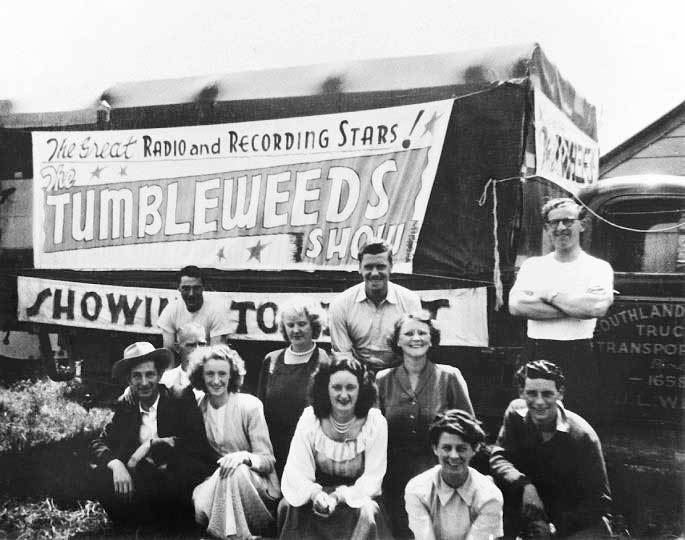
Cole Wilson and The Tumbleweeds with their touring wagon, early 1950s. - Paul Lloyd collection
We put much thought into which numbers we would record on disc. Cole was keen to do ‘Maple on the Hill’ but both Myra and I thought it was too monotonous. However, he was adamant about this and we did it. Following the enormous popularity of ‘Maple’, Cole said he was taking no notice of us two in future. We sure didn’t live that one down!
Our very first release (the ninth ever produced by the company, Pixie Williams’ ‘Blue Smoke’ being the first) comprised ‘The Bushmen’s Rodeo’ duo by Cole and me, backed by ‘Mother, Pal and Sweetheart’, solo by me. Altogether we recorded six numbers that first weekend, the other four being ‘Maple on the Hill’ backed by ‘Will You Be Lonesome Too’, and ‘When You Have No-one to Love You’ with ‘Too Late to Worry Too Blue to Cry’ on the flip side. All of these four were duos. These three recordings were released over the three or four months from January 1950.
We had awaited, with great anticipation, the release of our first recordings. At last, they were in the shops and we were feeling really good because they all proved to be very popular. Naturally, some of them, we felt, could have been improved upon but it was too late to rectify that. If there was something wrong with our performance of a number (not too bad) it was usually passed because to re-record it meant another 30 shillings ($3) for the new master acetate disc and this was an additional cost for the recording company. So a lot of minor “blues” got through that should not have. What a great difference it made to the recording industry when tape-recorders came on the scene!
We went to Wellington again in 1950 to do some more recordings and this time we did ‘I’ve Wandered Too Long’, ‘The Outlaw’, ‘Violets Blue’, ‘On The Plains Away Out There’, ‘Mama Don’t Like Music’, ‘Jealous Heart’, ‘The Faded Coat of Blue’, ‘You Played Love on the Strings of my Heart’, ‘The Sunny Mountainside’, ‘Rose of the Rio’, ‘On The Sunny Side of The Mountain’, ‘Highway Hobo’, ‘The Smoke Went Up The Chimney’ and ‘I’ll Not Forget My Mother’s Prayers’. Cole composed the first four of these but none of the rest of us had heard ‘The Outlaw’ until we were in Wellington and he had written this number at the last minute. We tried it out at the studio and then within half an hour it was on record. Certainly it has the atmosphere of a hard-riding chase and it proved to be a big hit.
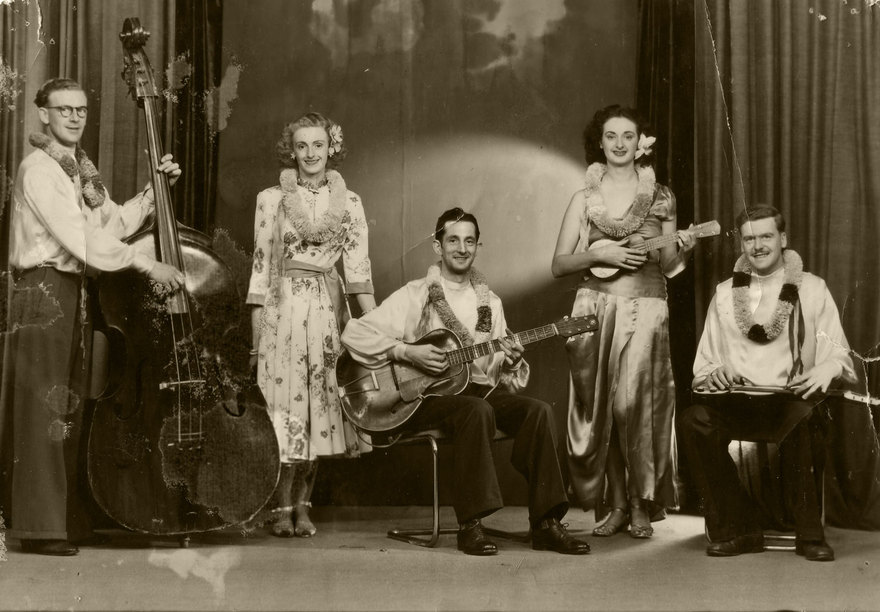
Colin McCrorie's Kalua Islanders, 1956; a spin-off group of the Tumbleweeds (L-R): Doug Reeve, Myra Hewitt, Cole Wilson, Nola Hewitt and Colin McCrorie. - Colin McCrorie collection
At a party on the Saturday night at the home of Stan Dallas (Tanza’s senior recording technician in Wellington) we were playing some music and Colin did some Hawaiian numbers which were really appreciated by Stan who said, “We’ve got to get some of these on record”.
We only had the Sunday morning to do this because Stan told us that there was a power cut from, by memory, 11am to 1pm and that the studio was not available in the afternoon. So early Sunday morning found us back at the studio “ripping off” ‘Mamula Moon’ and ‘Hilo March’, miraculously completed before 11am. McCrorie’s Kalua Islanders (whose personnel was identical to that of The Tumbleweeds in subsequent years, but was led by Colin) recorded six more Hawaiian numbers.
These first two sessions (1949 and 1950) were recorded in Wellington on acetate masters but subsequently we were able to record on tape in our hometown, Dunedin. This was better than all that travelling: we had to travel a day by train and a night crossing on the ferry from Lyttelton to get to Wellington, and the same on the return journey home to Dunedin.
From here in we did numerous recordings and broadcasts, so we were kept pretty busy. None of us had a car in those days and I remember what a hassle it was to get the five of us, plus our instruments, into a taxi. The big bass fiddle had the end of the fingerboard sticking out of the window. By this time Myra had joined the group so we had female duos and some trios, plus Cole’s and my solos and our duos. Myra was never confident enough to do solos.
We had very interesting LPs with all this variety but that didn’t stop one critic, a writer for NZ Truth who was reviewing one of our LPs, saying that our record was okay but a little monotonous. Evidently not a country fan! When we compared some other LPs, which had one vocalist singing all the way through, with our ones, we wondered just what made that critic tick. Of course, over the next few years we learned quite a lot about reporters and critics – the good and the not so good!
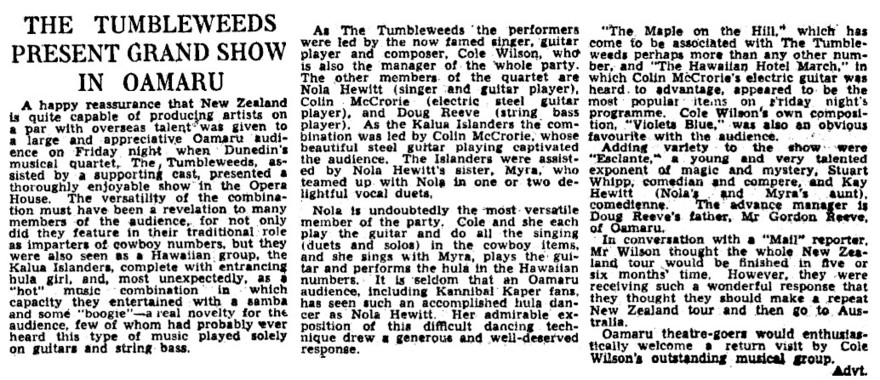
The Tumbleweeds Present Grand Show in Oamaru, The Press, 23 January 1952. - Papers Past
--
Published with the permission of the late Nola McCrorie